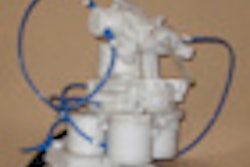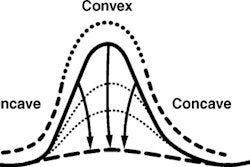ATLANTIC CITY, NJ - Prostate biopsy guided by contrast-enhanced color Doppler ultrasound is superior to systematic biopsy in a screening setting, according to research presented at the Leading Edge in Diagnostic Ultrasound conference this week.
"Although an increase in cancer detection could be obtained by combining targeted and systematic biopsy in our screening population, contrast-enhanced targeted biopsy alone is a reasonable approach to reduce the number of biopsy cores," said Dr. Leo Pallwein from the University Hospital Innsbruck in Innsbruck, Austria.
While color Doppler ultrasound can detect vascularity, there are limits to its ability to detect slow blood flow. However, microbubble contrast agents can improve detection of small blood vessels and slow flow, and therefore the detection of tumor vascularity, Pallwein said.
To evaluate whether a biopsy approach with contrast-enhanced color Doppler could detect cancers as well as grayscale ultrasound-guided systematic biopsy, the Austrian researchers studied 2,400 men between January 2002 and January 2006. The men had a mean age of 60, with a serum total prostate-specific antigen (PSA) greater than 1.25 ng/mL and a free/total PSA less than 18%.
One investigator performed targeted prostate biopsy using contrast-enhanced color Doppler ultrasound with a bolus injection of SonoVue (Bracco, Milan, Italy) on a Sequoia 512 ultrasound scanner (Siemens Healthcare, Malvern, PA) fitted with an end-fire probe operating at a frequency of 9 MHz. A second investigator then performed 10 systematic prostate biopsies in a standard spatial distribution guided by conventional grayscale ultrasound. Researchers then compared the cancer detection rates for the two techniques.
Of the 2,008 patients included in the study, 559 were found to have cancer. Targeted biopsy detected cancer in 476 patients, while systematic biopsy found cancer in 410 patients, Pallwein said. Cancer was detected by targeted biopsy alone in 149 patients and by systematic biopsy alone in 83 patients.
The targeted biopsy technique yielded a sensitivity of 85.2%, compared with 73.3% for the systematic biopsy approach. In addition, the targeted biopsy showed a 10.8% higher detection rate by biopsy core, Pallwein said. The targeted approach was also superior in detecting more cancers in lesions with a Gleason score of 7-10, he said.
Pallwein noted the limitations of contrast-enhanced ultrasound in this application, including the occurrence of false-positive results in patients with prostatitis.
The researchers also examined the last 400 patients in the study using a contrast pulse sequence (CPS) technique for detection of microvascularity. Of the 370 final patients included in this data subset, CPS showed suspicious findings in 159 patients. Cancer was later shown in 107 (67.2%) of these cases.
Forty-two of 211 patients without suspicious findings on CPS underwent systematic biopsy, and only one of those showed cancer, Pallwein said. After one-year follow-up, 169 patients were without a positive PSA velocity.
"CPS is useful for prostate cancer detection and improves detection of cancer with higher grades," he said. "Early enhancement seems to be the most sensitive sign in detection of neoplastic alterations."
While contrast-enhanced Doppler-guided prostate ultrasound biopsies offer the advantages of visualization and location of prostate cancer, as well as reductions in the amount of biopsies and the number of biopsy cores, it does suffer from limitations, Pallwein said.
The technique comes at some cost, including the requirement of a high-end ultrasound unit and the expense of the contrast agent. In addition, it typically requires a training learning curve of three to six months and suffers from false-positive findings in patients with benign prostatic hyperplasia (BPH) and prostatitis, according to Pallwein.
At the University Hospital Innsbruck, patients with elevated PSA (> 10 ng/mL) receive a contrast-enhanced ultrasound study. If a suspicious lesion is detected, they then undergo a combined biopsy approach, Pallwein said. Patients without suspicious ultrasound results are invited to participate in short-term follow-up, he said.
Contrast-enhanced ultrasound can help to detect prostate cancer, especially in lesions with high Gleason scores, Pallwein concluded.
"These new techniques are useful in patients with elevated PSA and can reduce the number of biopsies," he said. "Multicenter studies are necessary to prove our results."
By Erik L. Ridley
AuntMinnie.com staff writer
May 22, 2008
Related Reading
CEUS aids in discriminating hypoechoic prostate lesions, December 6, 2007
Prostate cancer staging assisted by 3D transrectal ultrasonography, August 9, 2007
CEUS shows promise for monitoring prostate ablation, May 24, 2006
Contrast ultrasound shows potential for prostate cancer detection, October 24, 2003
Prostate cancer screening interval of 4 years misses few cancers, October 1, 2003
Copyright © 2008 AuntMinnie.com


















